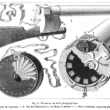The press is the only private institution protected in the constitution of a nation whose creation was engendered by angry and eloquent newspaper editors and pamphleteers. Lauri Lebo is a former reporter and author of the Devil in Dover, her account of the “intelligent design” trial she covered for the York Daily Record in Pennsylvania. She here considers the state of the fragile Fourth Estate and the prospect of democracy without it. — Lou Dubose.
IT WAS THE END OF FEBRUARY, and the end of a long week of dismal news for the newspaper industry: Denver’s Rocky Mountain News puts out its final edition; The Hearst Corporation threatens to close the San Francisco Chronicle if a buyer isn’t found quickly; Brian Tierney, the owner of thePhiladelphia Inquirer and its competitor the Daily News, files for bankruptcy protection.
But the small staff of the Anniston Star in northeastern Alabama still has the weekend papers to put out, even as the news business seems to be collapsing around them. At the 4 p.m. “budget meeting” where space is allocated for stories, the Star’s editor, Bob Davis, leads the staff discussion about the major stories of the day: Obama’s budget proposal; the state championship of the local basketball team; and a five-hour police chase of three escaped cows.
On a large white note board behind them, someone had written an inadvertent metaphor, quoting a line from the movie Dodgeball, “If you can dodge a wrench, you can dodge a dodge ball.”
The industry news is almost too depressing to read, even for news junkies. “I don’t read Romeneskoanymore,” the Star’s commentary editor, Phillip Tutor, said of the widely read media professional’s blog. In the past year, Jim Romenesko’s posts appeared to consist almost solely of news of layoffs, forced furloughs and cutbacks to already bare-bones budgets.
February’s bad news followed a series of events in the past two years that include the announcement of the closing of Seattle’s Hearst-owned Post-Intelligencer (which in March would change to an Internet-only format and reduce its news staff from 165 to 20); Media News’ purchase and gutting of Bay Area newspapers; and CEO Sam Zell seeking bankruptcy protection for his over-leveraged Tribune Co., which owns both the Chicago Tribune and Los Angeles Times.
According to the Web site graphicdesignr.net/papercuts, 15,600 journalism jobs were cut last year. At this point in 2009, the industry has lost 3,300.
In a concession to economic desperation, the New York Times recently began selling display advertising on its front page—after borrowing $250 million from Mexican billionaire Carlos Slim Helú, who had already acquired a 6.9 percent interest in the New York Times Company. On the last Sunday in February, the Anniston Star ran its first front-page ad as well—to the grumpy acknowledgment of the newsroom.
“It’s more garish than I expected,” one person griped during the meeting.
At the Star, editors talk apprehensively, cautiously, about where the industry will be in a year. Since Col. Harry Ayers started the paper in 1912, it has been a crusading voice in the small rural community sixty miles east of Birmingham. It was one of the few Southern papers during the civil-rights era to denounce segregation. George Wallace dubbed it “the Red Star.” Today H. Brandt “Brandy” Ayers, Col. Ayers’ son, is the publisher of the Star and four other area papers in the hills of northeast Alabama.
His father’s founding words remain at the top of the masthead: “It is the duty of a newspaper to become the attorney for the most defenseless among its subscribers.”
HIGH STAKES IN SMALL TOWNS—Small-town newspapers labor in the shadow of big metro dailies. Yet small-town papers serve as watchdogs at the grassroots level, where many of today’s important political and economic battles occur—at school-board, borough-council, and county-commission meetings far from the national spotlight.
Even if they are not as fragile as the big-city dailies, small-town newspapers are confronted with similar economic challenges. As the Internet and the recession continue to decimate print advertising revenue, analysts warn that there may soon come a day when many communities will be without their hometown newspaper.
It’s hard not to dissolve into sentimentality with descriptions of newspaper stories both apocryphal and true. On their best days, few places are more dynamic and fun than a newsroom. But nostalgia aside, what about the role of the Fourth Estate in preserving democracy?
“In the short term, a lot of things we report now in civil society will go unreported,” said Tom Rosenstiel, director of the Pew Research Center’s Project for Excellence in Journalism. “In the long term, however, it’s unclear.”
As editor and principal author of the project’s State of the News Media, which issues an annual report on the health of the business, Rosenstiel points out that the industry generated $40 billion in revenue last year. “But the numbers are dropping fairly steadily,” he said. “The decline is accelerating.”
Until the recession began, Rosenstiel noted, some papers continued to make what once was an industry standard of 20 percent to 30 percent profit. Despite the mass migration of readers to the Internet, traditional newspapers are keeping their audience when combined print circulation and Web visits are taken into account, he said.
Still, according to Rosenstiel, the industry is in a long-term structural crisis, and by the time the recession ends, the journalistic landscape will be a much different place.
“Nobody knows where we’re headed,” said Alan Mutter, an industry analyst, who writes about the state of media on his blog Reflections of a Newsosaur. “And if they tell you otherwise, they’re making it up.”
Newspapers seeded their own discontent in the mid-’90s with the creation of newspaper Web sites, Mutter said. It was cheaper simply to put the printed product online, rather than to create new content for the Web. Profits were great, and few worried that there was no strategic plan for what they were doing—which was to devalue their work. Oblivious to what they had helped set in motion, media executives continued to fuel stock-market profits by buying up other newspapers.
Then, faced with declining revenue, over-leveraged newspaper executives reacted by cutting costs in order to meet mounting debt obligations. The easiest costs to cut were reporters and editors, if for no other reason than, unlike employees who sell advertising, they generate no revenue.
Rosenstiel said that while there are ideas out there, the current business climate keeps most of them on the shelf: “It’s very hard to test a new revenue model in the worst economy that most Americans have ever experienced.”
PUBLIC INTEREST JOURNALISM—Some suggest that the business model of paid advertising and circulation is dead—we just haven’t yet acknowledged it. In order to develop new revenue sources for labor-intensive news gathering, non-profit foundations may be the answer.
Ed Brayton is a writer with the Center for Independent Media’s Michigan Messenger. He also runs the blog Dispatches from the Culture Wars. Brayton thinks the solution—to what some consider a terminal crisis in the profession—might be found in a hybrid approach combining elements of traditional journalism with blogging. “I’m not holding it out there that what we’re doing will replace newspapers,” Brayton said. “But maybe there is a way to replace a little of the investigative journalism that is being lost.”
In September, the Messenger broke a national news story, “Lose Your House, Lose Your Vote.” A county Republican chairman revealed the Michigan GOP’s plans to use a list of foreclosed homes to block people from voting. In January 2008, it exposed the fraudulent military record of Sovereign Deed’s CEO, whose company had been seeking government funding and tax breaks to establish a private disaster-response operation in northern Michigan.
Brayton joins others in suggesting that the solution may be, in part, removing journalism’s profit motive.
The 3-year-old Center for Independent Media is a non-profit network of state-based Internet news sites that operate in five states, with a national news bureau in Washington, D.C. It combines elements of both blogging and straight-up investigative reporting.
As a devoted blogger on the issue of civil liberties, Brayton is used to the accusation that he is one of the parasites, feeding off the free links of newspaper Web sites. While blogs can’t replace shoe-leather first-person newspaper journalism, he said, there is one thing at which bloggers excel. “We’re obsessive shits with huge chips on our shoulders.” They are also voracious researchers.
Information that is available, but all-too-often overlooked by traditional media, is ripe with opportunity for bloggers. The Pulitzer Prize work that Charlie Savage did when he was at the Boston Globe—reporting on the completely overlooked signing statements of George W. Bush—is one example that has served as a model for blogger-reporters. The material Savage reported on was in the public record.
Bloggers now post legislative documents and invite readers to pore over them—different blog posters combing through different sections; creating their own “volunteer” research staffs and collectively contributing to the discovery of information in a way newspaper reporters cannot.
“They’re like little worker ants, chewing on the public data, dispersing out that analytical processing power, breaking down data, finding little gems in a haystack,” Brayton said. “I think that’s a really healthy thing.”
PAY TO PLAY—Others say newspapers have to begin charging for the information that they now put out online. Right now, we have a “fiber-optic-fueled Tower of Babel,” Mutter said. “The idea of professionally edited and presented information, if that begins to go away and recede, other forms will replace it.” Just as nature abhors a vacuum, so does the Internet. Community journalism will remain and other forms will emerge from the chaos—although the community may be based more on common interests than geography.
Mutter has been calling for newspapers to wind back the clock a bit and reconsider their resistance to charging for the content that many of them post for no charge on their Web sites. Newsday is reported to be considering such a move. The Anniston Star already requires a subscription for some online articles. Most recently, Walter Isaacson, former Time magazine managing editor, suggested an iTunes method of micropayments for articles.
Mutter is not calling on newspapers to put up cyber walls and permit access solely to subscribers. Nor is he suggesting that readers be forced to pay for content they can find elsewhere for free—like baseball stats or Twitter alerts about the US Airways plane crashing into the Hudson River.
Rather, he is calling on newspapers to charge for what newspapers do best—original, investigative in-depth pieces that people will feel compelled to read. What’s really important, Mutter said, is the role that a newspaper plays in the community and society.
Some papers will follow the Rocky Mountain News and cease to exist. Others, like the Post Intelligencer and the Detroit Free Press, will phase out their print editions in exchange for much cheaper to produce online editions.
For places like the Anniston Star, the good news is that small-town newspapers may be best positioned to survive the upheaval. They face less direct competition from other news sources and blogs. Also, they have a more static pool of small advertisers who are not reaching consumers on line.
“The big-city metros are the ones getting squeezed,” Rosenstiel said. “They’re too big to be hyper-local and too small to be national and international.”
Bill Edwards, who edits the Star’s “Coffee Break” column, compares what’s happening to the industry to the meteor that may have killed off the dinosaurs. Small shrew-like mammals were able to take advantage of the evolutionary niche. They adapted to the new environment, changing, eventually becoming who we are today.
“Maybe that’s us,” he offered hopefully.
The Star is frequently listed as one of the best small-town newspapers in the country. In 2001, it received an Overseas Press Club Award—an unusual honor for a paper with a circulation of 25,000—for community journalism projects that have taken reporters around the globe.
In the mid-’90s, the Star’s commitment to community journalism and accountability took writer Chris Waddle to the South Pacific and to the Utah deserts to determine whether the local Army depot’s proposal to incinerate World War II-era nerve agent stockpiles was safe for the community. Today, Waddle is director of the Knight Community Journalism Fellows program, which offers a graduate degree in community journalism for University of Alabama students. The Star is their classroom.
The Star’s expansive office sits just outside of town, next to a wooded stretch of an old military base, on land purchased when the newspaper business was flush with profits. Last fall, the paper cut 10 percent of its staff, and one can now comfortably roller-skate through the building with little risk of bumping into anyone.
The Star doesn’t want to lose that crusading voice that led it to denounce segregation in the 1950s. “I’m not looking for controversy because I think it’s controversial,” editor Bob Davis said. “I’m looking because I think it’s important to be a voice for the community.”
A year ago, the newspaper published a series reporting on the local impact of media consolidation and the telecommunications act.
The idea for the series was born during a tornado warning. As Davis drove home from work, he tried to get information on the approaching storm. Flipping through the radio dial, all he could find was a rant by a conservative commentator based in New York.
The last two paragraphs of the final installment of the series stand as a hard look at the paper’s own future and an assessment of its role in its community:
“Without revenue, the print side is indeed in trouble. But the larger issue here is not so much who covers the news, but how it is covered and to what extent and to what level of fairness or balance, if you will.
“To reach deeper even, you touch what is the very best in media, to endeavor not only to inform but to encourage participatory democracy. Or put quite another way, to build within our society, local and nationally, a better citizenry.”






0 Comments